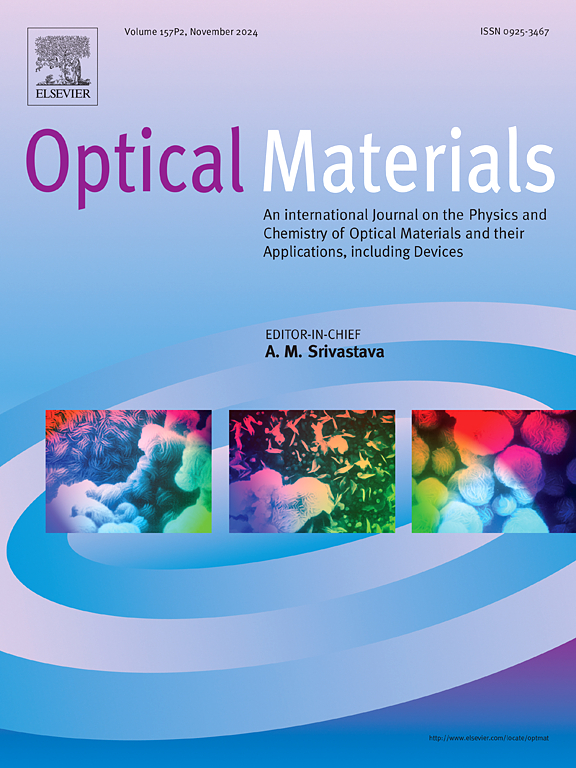Ce3+-doped chalcogenide glass fibre for laser beyond 4 microns wavelength: Glass material-integrity
IF 3.8
3区 材料科学
Q2 MATERIALS SCIENCE, MULTIDISCIPLINARY
引用次数: 0
Abstract
The 4-μm wavelength barrier encountered for mid-infrared fibre lasing based on heavy metal fluoride glasses has been overcome. We reported, in 2021, the first continuous wave, mid-infrared fibre laser operating beyond 4 μm at room temperature in a fibre with a Ce3+-doped selenide-chalcogenide core. Defects, such as crystallites in the core glass, could cause unwanted light-scattering, diminishing fibre laser efficiency. It is important to identify such optical loss mechanisms and eradicate them. Here, we report on investigating the material nano-structure of a chalcogenide-glass lasing fibre which exhibits 7 mW laser power output; the fibre has a Ce3+-doped core (8.5 μm diameter), concentrically surrounded by an inner- and outer-cladding, where both cladding-glasses are nominally the same composition. High resolution transmission electron microscopy and electron diffraction show that the core, inner-cladding and outer-cladding of the lasing fibre are internally nano-crystallite-free and amorphous. However, the external outer surface of the last 10 m of fibre drawn, of the total 100 m, contains monoclinic GeSe2 crystallites adjacent to discrete, small (<0.5 mm) wrinkled defects. The final length of fibre is drawn from the final part of the glass fibreoptic preform. The glass preform has as its outermost component an extruded chalcogenide glass tube. It is the last part of the tube which spends the longest time at high temperature inside the extruder during tube manufacture, encouraging heterogeneous nucleation at the tube outer-surface in contact with the extruder. These heterogeneous nuclei subsequently nucleate crystal growth during fibre-drawing in the outermost fibre surface.
用于波长超过4微米激光的Ce3+掺杂硫系玻璃纤维:玻璃材料的完整性
克服了基于重金属氟化物玻璃的中红外光纤激光所遇到的4 μm波长势垒。我们在2021年报道了首个连续波中红外光纤激光器,该激光器在室温下在Ce3+掺杂的硒化硫系核心光纤中工作在4 μm以上。缺陷,如核心玻璃中的晶体,可能导致不必要的光散射,降低光纤激光器的效率。识别这种光损耗机制并消除它们是很重要的。本文研究了一种具有7mw激光输出功率的硫系玻璃激光光纤的材料纳米结构;该光纤有一个Ce3+掺杂芯(直径8.5 μm),由内包层和外包层同心包围,其中两个包层玻璃名义上是相同的成分。高分辨透射电镜和电子衍射结果表明,激光光纤的芯层、内包层和外包层内部均为无纳米晶和非晶结构。然而,在全部100米的拉伸纤维中,最后10米的外表面含有单斜GeSe2晶体,邻近离散的小(<0.5 mm)褶皱缺陷。纤维的最终长度是从玻璃纤维预制体的最终部分绘制的。该玻璃预制体具有作为其最外层组件的挤压硫族玻璃管。在管材制造过程中,它是管材在挤出机内高温下停留时间最长的最后一部分,这促使管材与挤出机接触的外表面发生非均质成核。这些异质核随后在最外层纤维表面的纤维拉伸过程中形成成核晶体生长。
本文章由计算机程序翻译,如有差异,请以英文原文为准。
求助全文
约1分钟内获得全文
求助全文
来源期刊

Optical Materials
工程技术-材料科学:综合
CiteScore
6.60
自引率
12.80%
发文量
1265
审稿时长
38 days
期刊介绍:
Optical Materials has an open access mirror journal Optical Materials: X, sharing the same aims and scope, editorial team, submission system and rigorous peer review.
The purpose of Optical Materials is to provide a means of communication and technology transfer between researchers who are interested in materials for potential device applications. The journal publishes original papers and review articles on the design, synthesis, characterisation and applications of optical materials.
OPTICAL MATERIALS focuses on:
• Optical Properties of Material Systems;
• The Materials Aspects of Optical Phenomena;
• The Materials Aspects of Devices and Applications.
Authors can submit separate research elements describing their data to Data in Brief and methods to Methods X.
 求助内容:
求助内容: 应助结果提醒方式:
应助结果提醒方式:


